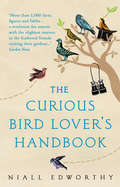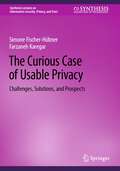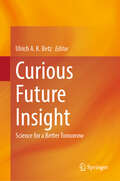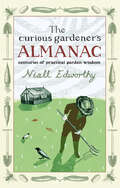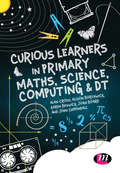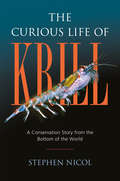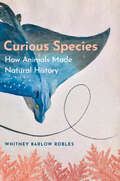- Table View
- List View
The Curious Bird Lover’s Handbook
by Niall EdworthyYou don't have to be a dedicated birdwatcher to be a bird lover. Millions of us love the sight and sound of them. And yet most of us know very little about their remarkable behaviour, incredible diversity and the story of their evolution. How do migrating birds know where to go?Are birds really descended from dinosaurs?How do birds have sex?This handbook sets about answering every interesting question there is to ask about birds. There are over 10,000 species in the world, including over 500 in Britain, some rare and endangered, some bizarre and beautiful, others common and familiar. As this captivating and often humorous handbook reveals, all of them are fascinating.The hardback edition titled "Bald Coot and Screaming Loon" was published in 2009. This paperback edition has been updated and includes a new foreword from the author.
A Curious Boy: The Making Of A Scientist
by Richard ForteyWhat makes a scientist? In a charming memoir, beloved and brilliant scientist Richard Fortey offers a tour of the natural world in all its joys, puzzles and curiosities.
The Curious Case of Usable Privacy: Challenges, Solutions, and Prospects (Synthesis Lectures on Information Security, Privacy, and Trust)
by Simone Fischer-Hübner Farzaneh KaregarThis book journeys through the labyrinth of usable privacy, a place where the interplay of privacy and Human-Computer Interaction (HCI) reveals a myriad of challenges, solutions, and new possibilities. Establishing a solid understanding of usable privacy research, practices, and challenges, the book illuminates for readers the often shadowy corridors of such a multifaceted domain and offers guidelines and solutions to successfully traverse the challenging maze. The book does not simply focus on data protection or legislative frameworks but also on what it takes for privacy to be safeguarded, understood, embraced, and easily practiced by all. It begins with a thorough exploration of the background of privacy tools and technologies, the evolution of privacy rules and regulations, and the backdrop upon which this narrative unfolds. After establishing this context, its next important focus is the current state and future directions of the field, including thefrontiers of usable privacy research in relation to the Internet of Things (IoT), usability of PETs, and usable privacy for UX and software developers. The book also considers the often-overlooked privacy narratives of marginalized communities and delves into the complexities of user-centric privacy. Readers are provided with a blueprint for addressing these hurdles and establishing pathways for a more privacy-conscious world. The text will be of interest to students studying Computer Science, Information Systems, or Law, as well as researchers and practitioners working in the fields of usable privacy, privacy by design, Privacy-Enhancing Technologies (PETs), or HCI. All will benefit from the book’s central deliberation of a question that echoes through time and technological advancements: why does usable privacy matter?
Curious Future Insight: Science for a Better Tomorrow
by Ulrich A. K. BetzThis book follows up the debate on the future of science and technology at the Curious2022 – Future Insight Conference, the second event in this conference series initiated on the occasion of Merck’s 350th anniversary. In the chapters, some of the world’s top scientists, managers and entrepreneurs explore breakthrough technologies and how they can be applied to make a better world for humanity. The book begins with an introduction to the vision of the conference “United by science for a better tomorrow” and the impacts caused by the pandemic, highlighting the importance of gathering like-minded people to discuss and support the advancement of science and technology for the benefit of humanity. In the first part of the book, readers will also find a chapter written by the Executive Board of Merck KGaA discussing the importance of curiosity for innovation and an overview of the company’s contribution in the areas of life sciences, healthcare andelectronics forward-moving the scientific discovery. The second part of the book offers insights of some of the scientific topics discussed at the conference, and particular attention is given to new therapies and sustainability. In the final part of the book, readers will find some thoughts on ethical principles guiding our application of science and technology to create a bright future for humanity, and diverse perspectives on topics such as health, life sciences, nutrition, material sciences, digitalization, AI, energy, mobility, space flight, robotics, the secrets of the human mind and new ways of working together. Given its interdisciplinary appeal, the book will inspire curiosity in a wide readership, from scholars and researchers to professionals with an interest in exploring the future of science and technology, solving the problems of today, and paving the way for a better tomorrow. Chapters “From a 350th Anniversary to a Global Movement: United by Science for a Better Tomorrow” and “ Advancing Human Progress as a Twenty-First-Century Science and Technology Pioneer” are available open access under a Creative Commons Attribution 4.0 International License via link.springer.com.
The Curious Gardener's Almanac: Centuries Of Practical Garden Wisdom
by Niall EdworthyThe Curious Gardener's Almanac contains over 1000 entries of remarkable information about flowers, vegetables, fruits, trees, herbs, insects, birds, water, soil, tools, composts, climate, recipes, gardens and gardeners, myths, superstitions, biodynamics..In short it is a collection as profuse and variegated as gardening itself. Woven into this wealth of knowledge are famous quotations, anecdotes, traditional sayings, lines of verse, and words of rural wisdom. The spirit and focus of the Almanac is British but the wider picture is international as so much of our gardens originated from overseas.Dry or dull information has no place in the almanac and its presentation is as appealing as the content.
The Curious History of Relativity: How Einstein's Theory of Gravity Was Lost and Found Again (PDF)
by Jean EisenstaedtBlack holes may obliterate most things that come near them, but they saved the theory of general relativity. Einstein's theory was quickly accepted as the true theory of gravity after its publication in 1915, but soon took a back seat in physics to quantum mechanics and languished for decades on the blackboards of mathematicians. Not until the existence of black holes by Stephen Hawking and Roger Penrose in the 1960s, after Einstein's death, was the theory revived. Almost one hundred years after general relativity replaced Newton's theory of gravitation, The Curious History of Relativity tells the story of both events surrounding general relativity and the techniques employed by Einstein and the relativists to construct, develop, and understand his almost impenetrable theory. Jean Eisenstaedt, one of the world's leading experts on the subject, also discusses the theory's place in the evolution of twentieth-century physics. He describes the main stages in the development of general relativity: its beginnings, its strange crossing of the desert during Einstein's lifetime while under heated criticism, and its new life from the 1960s on, when it became vital to the understanding of black holes and the observation of exotic objects, and, eventually, to the discovery of the accelerating universe. We witness Einstein's construction of his theory, as well as the work of his fascinated, discouraged, and enthusiastic colleagues--physicists, mathematicians, and astronomers. Written with flair, The Curious History of Relativity poses--and answers--the difficult questions raised by Einstein's magnificent intellectual feat.
The Curious History of the Heart: A Cultural and Scientific Journey
by Vincent M. FigueredoFor much of recorded history, people considered the heart to be the most important organ in the body. In cultures around the world, the heart-not the brain-was believed to be the location of intelligence, memory, emotion, and the soul. Over time, views on the purpose of the heart have transformed as people sought to understand the life forces it contains. Modern medicine and science dismissed what was once the king of the organs as a mere blood pump subservient to the brain, yet the heart remains a potent symbol of love and health and an important part of our cultural iconography. This book traces the evolution of our understanding of the heart from the dawn of civilization to the present. Vincent M. Figueredo-an accomplished cardiologist and expert on the history of the human heart-explores the role and significance of the heart in art, culture, religion, philosophy, and science across time and place. He examines how the heart really works, its many meanings in our emotional and daily lives, and what cutting-edge science is teaching us about this remarkable organ. Figueredo considers the science of heart disease, recent advancements in heart therapies, and what the future may hold. He highlights the emerging field of neurocardiology, which has found evidence of a 'heart-brain connection' in mental and physical health, suggesting that ancient views hold more truth than moderns suspect.
Curious Learners in Primary Maths, Science, Computing and DT
by Karen Beswick Jon Chippindall Jon Board Alison Borthwick Alan CrossWhether it is in the National Curriculum or the Teachers' Standards, promotion of children's curiosity is highlighted as a key part of effective teaching. Curiosity has the potential to enhance learning in all curriculum subjects but it has a special connection with scientific thinking. A curious approach can open up learning in science, computing, design technology and mathematics. This text explores how teachers can harness the power of curiosity in their classroom. Full of practical teaching ideas for engaging learners and making lessons more exciting, it highlights the ways in which STEM subjects can be taught together. Coverage includes: the place of curiosity in subject teaching how curiosity contributes to a learner's overall capability examples of curiosity in primary STEM classes case studies which exemplify curiosity.
Curious Learners in Primary Maths, Science, Computing and DT (PDF)
by Alan Cross Alison Borthwick Jon Board Jon Chippindall Karen BeswickWhether it is in the National Curriculum or the Teachers' Standards, promotion of children's curiosity is highlighted as a key part of effective teaching. Curiosity has the potential to enhance learning in all curriculum subjects but it has a special connection with scientific thinking. A curious approach can open up learning in science, computing, design technology and mathematics. This text explores how teachers can harness the power of curiosity in their classroom. Full of practical teaching ideas for engaging learners and making lessons more exciting, it highlights the ways in which STEM subjects can be taught together. Coverage includes: the place of curiosity in subject teaching how curiosity contributes to a learner's overall capability examples of curiosity in primary STEM classes case studies which exemplify curiosity.
The Curious Life of Krill: A Conservation Story From The Bottom Of The World
by Stephen NicolKrill-it’s a familiar word that conjures oceans, whales, and swimming crustaceans. Scientists say they are one of most abundant animals on the planet. But when pressed, few people can accurately describe krill or explain their ecological importance. Antarctic krill have used their extraordinary adaptive skills to survive and thrive for millions of years in a dark, icy world far from human interference. But with climate change melting ice caps at the top and bottom of the world, and increased human activity and pollution, their evolutionary flexibility to withstand these new pressures may not be enough.Eminent krill scientist Stephen Nicol wants us to know more about this enigmatic creature of the sea. He argues that it’s critical to understand krill’s complex biology in order to protect them as the krill fishing industry expands. This account of Antarctic krill-one of the largest of eighty-five krill species-takes us to the Southern Ocean to learn firsthand the difficulties and rewards of studying krill in its habitat. Nicol lays to rest the notion that krill are simply microscopic, shrimplike whale food but are in fact midway up the food chain, consumers of phytoplankton and themselves consumed by whales, seals, and penguins. From his early education about the sex lives of krill in the Bay of Fundy to a krill tattoo gone awry, Nicol uses humor and personal stories to bring the biology and beauty of krill alive. In the final chapters, he examines the possibility of an increasingly ice-free Southern Ocean and what that means for the fate of krill-and us.Ocean enthusiasts will come away with a newfound appreciation for the complex ecology of a species we have much to learn from, and many reasons to protect.
Curious Species: How Animals Made Natural History
by Whitney Barlow RoblesA compelling and innovative exploration of how animals shaped the field of natural history and its ecological afterlives Can corals build worlds? Do rattlesnakes enchant? What is a raccoon, and what might it know? Animals and the questions they raised thwarted human efforts to master nature during the so-called Enlightenment—a historical moment when rigid classification pervaded the study of natural history, people traded in people, and imperial avarice wrapped its tentacles around the globe. Whitney Barlow Robles makes animals the unruly protagonists of eighteenth-century science through journeys to four spaces and ecological zones: the ocean, the underground, the curiosity cabinet, and the field. Her forays reveal a forgotten lineage of empirical inquiry, one that forced researchers to embrace uncertainty. This tumultuous era in the history of human-animal encounters still haunts modern biologists and ecologists as they struggle to fathom animals today. In an eclectic fusion of history and nature writing, Robles alternates between careful historical investigations and probing personal narratives. These excavations of the past and present of distinct nonhuman creatures reveal the animal foundations of human knowledge and show why tackling our current environmental crisis first requires looking back in time.
Curious Tales from Chemistry: The Last Alchemist in Paris and Other Episodes
by Lars ÖhrströmThis is a book about discovery and disaster, exploitation and invention, warfare and science - and the relationship between human beings and the chemical elements that make up our planet. Lars Ohrstrom introduces us to a variety of elements from S to Pb through tales of ordinary and extraordinary people from around the globe. We meet African dictators controlling vital supplies of uranium; eighteenth-century explorers searching out sources of precious metals; industrial spies stealing the secrets of steel-making. We find out why the Hindenburg airship was tragically filled with hydrogen, not helium; why nail-varnish remover played a key part in World War I; and the real story behind the legend of tin buttons and the downfall of Napoleon. In each chapter, we find out about the distinctive properties of each element and the concepts and principles that have enabled scientists to put it to practical use. These are the fascinating (and sometimes terrifying) stories of chemistry in action.
Curious2018: Future Insights in Science and Technology
by Ulrich A. K. BetzThis book expands the debate on the future of science and technology at the Curious2018 – Future Insight Conference, held on the occasion of Merck’s 350-year anniversary. In the respective chapters, some of the world’s top scientists, managers and entrepreneurs explore breakthrough technologies and how they can be applied to make a better world for humanity.Divided into three parts, the book begins with an introduction to the vision of the conference and to the importance of curiosity for innovation, while also exploring the latest scientific developments that are shaping the future of healthcare, medicine, the life and material sciences, digitalization and new ways of working together. In the second part, particular attention is paid to new therapies and diagnostics; here, readers will learn how synthetic biology and chemistry are being used to solve problems that are essential to the future of humanity. The role of in-silico research is also discussed. In the final part of the book, readers will find some thoughts on ethical principles guiding our application of science and technology to create a bright future for humanity.Given its interdisciplinary appeal, the book will inspire curiosity in a wide readership, from scholars and researchers to professionals with an interest in exploring the future of science and technology, solving the problems of today, and paving the way for a better tomorrow.Chapters 1, 2, 3 and 17 are available open access under a Creative Commons Attribution-NonCommercial 4.0 International License via link.springer.com.
Current Advances in Biotechnological Production of Xylitol: Fermentative Production of Xylitol
by Maria das Graças de Almeida Felipe Anuj Kumar ChandelThis book explores recent advances in the microbial production of xylitol and its applications in food and medical sector. Xylitol is an important biomolecule from lignocellulose biorefinery which is produced from the xylose by chemical reactions or microbial fermentation methods. Currently, the demand of xylitol at commercial scale is being met through chemical methods. However, recent breakthroughs made in plant cell wall destruction, genetic engineering to develop the designer microorganisms, fermentation methods and media formulations and downstream processing have led the ways for sustainable production of xylitol at commercial scale in lignocellulose biorefineries. Microbial production of xylitol is preferred over the chemical processes as it is environmentally friendly, higher process efficiency with the desired product yield, and product recovery with minimum impurities. This book is a unique compilation of 11 book chapters written by experts in their respective fields. These chapters present critical insights and discuss the current progress and future progress in this area into fermentative xylitol production.Chapter 9 is licensed under the terms of the Creative Commons Attribution 4.0 International License. For further details see license information in the chapter.
Current Advances in Coconut Biotechnology (Current Plant Science and Biotechnology in Agriculture #35)
by C. Oropeza J. M. Santamaría J. L. Verdeil G. R. Ashburner R. CardeñaThe coconut palm occupies a significant place in the world economy as an important subsistence crop in all the areas in which it is grown. Relatively few countries are able to export any quantity of coconut products because of increasing home demands coupled with low productivity. Yields are generally well below potential despite recent developments with improved planting stock and agronomic practices. In the last 50 years, both these aspects have received considerable attention, but the focus is shifting to investigate how the use of recently developed biotechnological techniques- can benefit the coconut industry. This volume, the result of the International Symposium on Coconut Biotechnology (held in December 1997 in Merida, Yucatan, Mexico), describes recent research in three important areas. Standard plant breeding techniques used with coconut have produced improved planting material, but progress is inevitably very slow. Can more rapid genetic improvement be obtained using molecular techniques? The papers presented in this section suggest that such techniques will open up exciting new prospects, but only after basic information has been gathered on the genetic status of existing coconut stocks. Research using microsatellite techniques seems to provide a useful tool to help to classifying these stocks. However, only a combination of classical breeding methods with modem techniques will lead to the rapid improvement which is required to supply material for urgent replanting programs.
Current Advances in Fern Research
by Helena FernándezFerns, collectively, represent an ancient species of vascular plant which has a direct connection to the beginning of life on Earth. Today they are valued for their ornamental appeal, environmental benefit or as sources of health benefiting metabolites. Current pteridology, the study of fern, encompasses a wide range of research activities including, but not limited to, plant physiology, stress tolerance, genetics and genomics. The goal of this book is to compile the most relevant research done with ferns during the last decade. It is organized into four parts: I, Biology and Biotechnology; II, Evolution and Conservation; III, Metabolism and Genetic Resources, and IV, Environment. Each section reveals the utilization of ferns as a tool to explore challenges unique to plant development and adaptation.This project represents our collective effort to raise the awareness of ferns as a model system to study higher plant functions. Among the distinctive features of our proposed book are: (i) a wide range of topics with contributing researchers from all around the world, and (ii) recent advances of theoretic and applied knowledge with implications to crop species of economic value.
Current Advances in Mechanical Engineering: Select Proceedings of ICRAMERD 2020 (Lecture Notes in Mechanical Engineering)
by Saroj Kumar Acharya Dipti Prasad MishraThis book presents select proceedings of the International Conference on Recent Advances in Mechanical Engineering Research and Development (ICRAMERD 2020). The contents focus on latest research and current problems in various branches of mechanical engineering. Some of the topics discussed here include fracture and failure analysis, fuels and alternative fuels, combustion and IC engines, advanced manufacturing technologies, powder metallurgy and rapid prototyping, industrial engineering and automation, supply chain management, design of mechanical systems, vibrations and control engineering, automobile engineering, fluid mechanics and machines, heat transfer, composite materials, micro and nano-engineering for energy storage and conversion, and modeling and simulations. The wide range of topics presented in this book can make it useful for beginners, researchers as well as professionals in mechanical engineering.
Current Advances in Osteosarcoma (Advances in Experimental Medicine and Biology #804)
by Eugenie S. KleinermanCurrent Advances in Osteosarcoma edited by Dr. Eugenie S. Kleinerman summarizes molecular and genetic characteristics, new therapeutic ideas, and biological characteristics that have been uncovered in the past 10 years. Osteosarcoma is an aggressive malignant neoplasm and it is also the most common histological form of bone cancer. It accounts for approximately 56% of new bone tumors, making it the most primary malignant bone tumor in children and adolescents. The lungs are the most common site of metastases and once osteosarcoma spreads to the lungs, it is very difficult to treat. To improve the outcome of this disease, the biology of osteosarcoma needs to be better understood. There are numerous investigators around the world who have made seminal discoveries about the important molecular pathways and genetic alterations that contribute to the development and metastases of osteosarcoma. Other investigators have proposed novel therapeutic strategies including some based on the molecular and genetic phenotype of the disease. Current Advances in Osteosarcoma summarizes all of these new discoveries in one singular text, which will help move the field forward.
Current Advances in Osteosarcoma: Clinical Perspectives: Past, Present and Future (Advances in Experimental Medicine and Biology #1257)
by Eugenie S. Kleinerman Richard GorlickThis thoroughly revised second edition complied in 2 books is an up-to-date overview of the current clinical advances in sarcoma and osteosarcoma. The new edition features detailed, in-depth discussions of microRNAs in osteosarcoma, historical perspectives of chemotherapy in the treatment of the disease, tumor targeted IL12 therapy and HER2 targeted therapy, the role of enhancer elements in regulating the prometastatic transcriptional program and more. Further, these essential volumes also includes new insights on Wnt signaling in osteosarcoma, the role of genomics, genetically modified T-cell therapy, liquid biopsy, oncolytic viruses, immunophenotyping, receptor tyrosine kinases and epigenetic-focused approaches for treatment of osteosarcoma metastases, as well as thoughts on the current standard of treatment for patients suffering from these cancers. In the years since the previous edition, there have been numerous new developments in this rapidly changing field; this new edition is both timely and urgently needed. When taken together these companion volumes, Current Clinical (Book 1) and Scientific (Book 2) Advances in Osteosarcoma, are a timely and urgently needed guide for laboratory investigators and clinical oncologists focused in sarcoma.
Current Advances in the Science of Osteosarcoma: Research Perspectives: Tumor Biology, Organ Microenvironment, Potential New Therapeutic Targets, and Canine Models (Advances in Experimental Medicine and Biology #1258)
by Eugenie S. Kleinerman Richard GorlickThis thoroughly revised second edition is an up-to-date overview of the new advances in the knowledge of the basic science in sarcoma and osteosarcoma. It features detailed, in-depth discussions of microRNAs in osteosarcoma, historical perspectives of chemotherapy in the treatment of the disease, tumor targeted IL12 therapy and HER2 targeted therapy, the role of enhancer elements in regulating the prometastatic transcriptional program and more. Further, this essential volume also includes new insights on Wnt signaling in osteosarcoma, the role of genomics, genetically modified T-cell therapy, liquid biopsy, oncolytic viruses, immunophenotyping, receptor tyrosine kinases and epigenetic-focused approaches for treatment of osteosarcoma metastases, as well as thoughts on the current standard of treatment for patients suffering from these cancers. In the years since the previous edition, there have been numerous new developments in this rapidly changing field; this new edition is both timely and urgently needed. When taken together these companion volumes, Current Clinical (Book 1) and Scientific (Book 2) Advances in Osteosarcoma, are a timely and urgently needed guide for laboratory investigators and clinical oncologists.
Current against Voltage Graph for a fixed resistor (large print)
by RnibOn this page is a graph with current on the vertical Y-axis plotted against voltage on the horizontal X-axis showing the effect on voltage of increasing current through a fixed resistor. There is a symbol for a fixed resistor in the top left of the page. There is a locator dot shown, which will be at the top left of the page when the image is the correct way up. The graph is in the centre of the page. It has a grid of squares with fine dashed lines. The X-axis is shown as a heavy horizontal line stretching across the centre of the page. The Y-axis is a heavy vertical line in the centre of the page. The plotted line of the graph is a heavy dashed line from the bottom left of the graph to the top right. The line is straight because current is directly proportional to voltage for a fixed resistor.
Current against Voltage Graph for a fixed resistor (UEB contracted)
by RnibOn this page is a graph with current on the vertical Y-axis plotted against voltage on the horizontal X-axis showing the effect on voltage of increasing current through a fixed resistor. There is a symbol for a fixed resistor in the top left of the page. There is a locator dot shown, which will be at the top left of the page when the image is the correct way up. The graph is in the centre of the page. It has a grid of squares with fine dashed lines. The X-axis is shown as a heavy horizontal line stretching across the centre of the page. The Y-axis is a heavy vertical line in the centre of the page. The plotted line of the graph is a heavy dashed line from the bottom left of the graph to the top right. The line is straight because current is directly proportional to voltage for a fixed resistor.
Current against Voltage Graph for a fixed resistor (UEB uncontracted)
by RnibOn this page is a graph with current on the vertical Y-axis plotted against voltage on the horizontal X-axis showing the effect on voltage of increasing current through a fixed resistor. There is a symbol for a fixed resistor in the top left of the page. There is a locator dot shown, which will be at the top left of the page when the image is the correct way up. The graph is in the centre of the page. It has a grid of squares with fine dashed lines. The X-axis is shown as a heavy horizontal line stretching across the centre of the page. The Y-axis is a heavy vertical line in the centre of the page. The plotted line of the graph is a heavy dashed line from the bottom left of the graph to the top right. The line is straight because current is directly proportional to voltage for a fixed resistor.
Current Algebra and Anomalies
by Sam Treiman Roman JackiwCurrent algebra remains our most successful analysis of fundamental particle interactions. This collection of surveys on current algebra and anomalies is a successor volume to Lectures on Current Algebra and Its Applications (Princeton Series in Physics, 1972).Originally published in 1986.The Princeton Legacy Library uses the latest print-on-demand technology to again make available previously out-of-print books from the distinguished backlist of Princeton University Press. These editions preserve the original texts of these important books while presenting them in durable paperback and hardcover editions. The goal of the Princeton Legacy Library is to vastly increase access to the rich scholarly heritage found in the thousands of books published by Princeton University Press since its founding in 1905.
